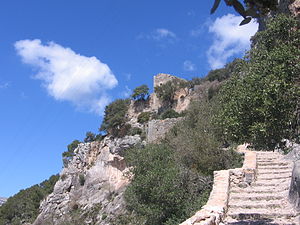Castell d'Alaró
| Castell d'Alaró | ||
|---|---|---|
|
Castell d'Alaro and climb to the castle gate |
||
| Creation time : | before 900 | |
| Conservation status: | ruin | |
| Construction: | Limestone - masonry | |
| Place: | Alaró | |
| Geographical location | 39 ° 44 '2 " N , 2 ° 47' 30.1" E | |
| Height: | 817 msnm | |
|
|
||
The Castell d'Alaró ( Castilian Castillo de Alaró ) is the ruin of a rock castle below the 825 meter high mountain peak Puig d'Alaró in the town of Alaró on the Spanish Mediterranean island of Mallorca . It is located about three kilometers north of the small town of Alaró. The name Alaró is derived from the Arabic al'-run and means Roman , Byzantine or Christian . The fort can be reached via an asphalt road from Alaró and a subsequent path . The ruin has been a Spanish cultural monument since 1931 and today belongs to the city of Alaró, the diocese of Mallorca and a private owner.
history
The origin of the 817 meter high facility can be traced back to the Bronze Age . The Romans later fortified the mountain to secure the surrounding valleys. Historical records of a building used for military purposes have existed since 902 when the Saracens occupied Mallorca. At that time there was already a fortress that resisted the conquerors for eight years and six months. When King James I ended the Moorish rule in 1229, the fleeing Mallorcan Muslims left the castle to him in 1231. After the invasion of Mallorca, Jacob I briefly gave the Templars control of the strategically important military facility.
In 1285 the Castell d'Alaró was attacked again, this time by the Aragonese King Alfons III. His uncle James II , as King of Mallorca, was a vassal of the Crown of Aragon, but was considered unreliable and had secretly allied with France, which was willing to take Aragon. Alfonso II led a punitive expedition to Mallorca and was able to conquer Palma in a few days, but initially not the Castell d'Alaró. When the Kingdom of Mallorca was finally defeated by Peter IV of Aragón in 1349, the Castell d'Alaró also fell. In the fourteenth and fifteenth centuries the castle was gradually abandoned. During the plague in 1564, the building served as a quarantine station and emergency hospital. There was a military occupation until 1741. From this point on, the place was used exclusively for religious purposes after a chapel had been built in 1622.
building
Originally the castle complex consisted of a fortress wall with five towers. Remains of the fortress wall, the entrance gate (Torre de l'Homenatge) and the southern main tower (Torre de la Cova) have been preserved . It served the Moors as a prison. Below the tower is the stalactite cave of Sant Antoni .
The oratorio Nostra Senyora del Refugi above the castle complex dates from the 17th century . There is also an inn, the Refugi del Castell d'Alaró hostel as part of the GR 221 long-distance hiking trail, as well as five cisterns that could be of Arab origin. It is possible that some of these still visible depressions were also used as snow houses .
Traditions and Legends
A pilgrimage to the castle is made during Pancaritat or on the Sunday of the Angel (the Sunday after Easter) and on September 8th, the day of the birth of the Virgin Mary.
When King Alfonso III. von Aragon tried to annex the Balearic Islands to his empire and besieged the Castell d'Alaro during the campaign in 1285, the two commanders of the fortress and loyal followers of the Mallorcan King James II, Cabrit and Bassa, refused to hand them over to the Aragonese troops. They ridiculed Aragonese negotiators who asked the crew to give up, and let King Alfonso tell them that Anfós ('grouper') was eaten with sauce in Mallorca. This play on words angered the king. When the fort had to give in to the opposing forces after a long siege, the two were captured, impaled and roasted alive, alluding to their names ( Cabrit = billy goat, Brasa = charcoal). Cabrit and Bassa are among the great historical figures of the Balearic Islands. One rib of each of the two martyrs remained on the Puig d'Alaró. The relics are kept above the castle ruins in the chapel Nostra Senyora del Refugi .
literature
- Josep Sureda Blanes: El Castillo de Alaró . In: Panorama balear . No. 65 , 1957.
- Maria en los pueblos de España: Guía para Visitar Los Santuarios Marianos de Baleares . In: Ediciones Encuentro . Madrid 1997, p. 110-111 . ( limited preview in Google Book search)
Web links
- History and photographs of the castle, accessed April 14, 2012
Individual evidence
- ↑ Susanne Engler: Serra de Tramuntana: Travel Guide . Triangle Postals SL, Sant Lluis 2009, ISBN 978-84-8478-403-6 , p. 47 .
- ↑ a b Jochen Knüpling: Mallorca hiking guide . Reiseuchverlag Iwanowski, Dormagen 2009, ISBN 978-3-933041-77-7 . ( limited preview in Google Book search)
- ↑ Bernd FWS de Mistra: Inconvenient truths: The knowledge of the Templars and the religions of Christians, Jews and Muslims . Pro BUSINESS, Berlin 2011, ISBN 978-3-86386-042-4 , pp. 137 . ( limited preview in Google Book search)
- ↑ Hiking tours Mallorca , accessed on April 12, 2012.


